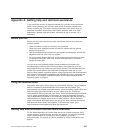
Solving undetermined problems
If the diagnostic tests did not diagnose the failure or if the server is inoperative, use
the information in this section.
If you suspect that a software problem is causing failures (continuous or
intermittent), see “Software problems” on page 158.
Damaged data in CMOS memory or damaged BIOS code can cause undetermined
problems. To reset the CMOS data, use the clear CMOS jumper (JP2) to clear the
CMOS memory; see “System board jumpers” on page 14. If you suspect that the
BIOS code is damaged, see “Updating (flash-update) the BIOS code on the server”
on page 232.
Check the LEDs on all the power supplies. If the LEDs indicate that the power
supplies are working correctly, complete the following steps:
1. Turn off the server.
2. Make sure that the server is cabled correctly.
3. Remove or disconnect the following devices, one at a time, until you find the
failure. Turn on the server and reconfigure it each time.
v Any external devices.
v Surge-suppressor device (on the server).
v Modem, printer, mouse, and non-Lenovo devices.
v Each adapter.
v Hard disk drives.
v Memory modules. The minimum configuration requirement is one 512 MB
DIMM on the system board.
v Service processor.
The following minimum configuration is required for the server to start:
v One microprocessor
v One 512 MB DIMM on the system board
v One power supply
v Power cord
v Power backplane
v System board
4. Turn on the server. If the problem remains, suspect the following components in
the following order:
a. System board
b. Memory module
c. Microprocessor
d. SAS/SATA controller
If the problem is solved when you remove an adapter from the server but the
problem recurs when you reinstall the same adapter, suspect the adapter; if the
problem recurs when you replace the adapter with a different one, suspect the
system board or SAS/SATA controller.
If you suspect a networking problem and the server passes all the system tests,
suspect a network cabling problem that is external to the server.
Chapter 5. Diagnostics 245


















